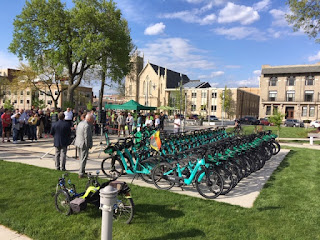A group of residents in the Wellington Heights neighborhood, led by my friend and fellow urbanist Phillip Platz, have ambitions for Redmond Park, which occupies a half-block-sized triangle of land (1.22 acres) along 3rd Avenue, Park Avenue and 16th Street SE. It has a playground, splash pad, and picnic tables. When I studied park access five summers ago (cited below), I noted afternoon use by adults and children. I noted "Both days small groups of adults used the park as a picnic ground or meeting place." The park also serves as a path from surrounding residences to the Hy-Vee Food Store across 1st Avenue.
Could a more attractive Redmond Park serve as more of a community gathering place? The group describes its goal as "leveraging innovative programming and the arts to improve the safety, livability, and potential of the Wellington Heights neighborhood" (Redmond Park 2019). They're hitting the ground running this summer with "Stop the Violence" picnics on the last Sunday of each month, and a Back to Summer Party celebrating the end of the school year. I want to see anything that anyone can dream of, happening, Phillip told CBS2 News. But I know we gotta start small... and I know we have to start with what's the right fit (Anderson 2019).
| Source: redmondpark.org |
- Its roughly one square mile area holds 5806 residents; at 5519 people per square mile it is unusually dense for Cedar Rapids. It lost 627 residents and 178 housing units between 2010 and 2016. It is 22 percent nonwhite, roughly divided between black and mixed-race, high for Cedar Rapids and especially high for Iowa.
- The unemployment rate is 7.6 percent; the poverty rate is 15.7 percent. Its median annual household income is $63472, low for the area but at about the national median.
- 80.8 percent of homes are single-family detached, 76.1 percent of residents live in homes they own, 75.1 percent drive to work alone; these figures are also low for CR but closer to the national median. The median age of housing units is an amazing 80 years (i.e. construction in 1939).
 |
| DJing the Stop the Violence party Sunday 5/26 |
Those in the neighborhood seem more interested in developing the park as a gathering space rather than a city destination, which is fine. Here are a couple ways urbanism can help. First, draw on the experiences and wishes of everyone in the neighborhood, white and black, newcomers and long-term residents. The community and economic benefits of a successful park (Cox and Streeter 2019, Florida 2019) only accrue to the whole community if the whole community is included. In a neighborhood where change is being driven by newer white residents, the thoughts of Pete Saunders (cited below) on the broader conundrum of gentrification are pertinent:
The essential ingredient [in gentrification management] is engagement. Residents in potentially gentrifying communities can no longer afford to simply pass each other by. If newcomers seek to retain the authentic character of the community that attracted them, and longtime residents are to obtain the amenities they desire to become a complete community once again, dialogue is a necessity.(Some time ago I read, I forget where, about a neighborhood in another town that worked to get the city to build a play area in a local park for their many dogs. Then they noticed that only white residents were using it. Someone asked a black person walking a dog across the street whether they ever used the park, and she said, "Oh no, that's the white people's park.")
Secondly, successful parks depend as much on what's around the park as on what's in it. Jane Jacobs recommends a mixed-use neighborhood that "directly produces for the park a mixture of users who enter and leave the park at different times" (1961: 125). Are there opportunities for commercial development near the park that could create synergies, like Jacobs's hypothetical cafe across the street from the skating pond, or the Washington market cited by Cox and Streeter? I'm not suggesting knocking down any of the houses around the park, but what about allowing or even encouraging in-home businesses? What about making better use of nearby open space a block away at Park Court and 2nd Avenue, as well as at 16th and Washington? Johnson School is only a block away, too, though obviously its basketball hoops and playground equipment are going to be spoken for a good bit of the time.
It may seem uncontroversial to wish for a better, more vibrant park; doing what it takes will require a lot of tough conversations. At the Wellington Heights Neighborhood Association meeting earlier this month, there was considerable interest in park development. At the same time, there was concern about people who might cause problems: youth with guns, the homeless, car traffic speeding down residential streets. (Park Avenue SE is currently one-way west along the south end of the park; when the city announced plans to make it two-way, there was sufficient outcry from residents that those plans were cancelled. Quite a few people at the meeting seemed to think this was a good outcome.)
In an ideal world, enhancing Redmond Park would attract more and more of the "right" people, and none of the "wrong" people. In the real world, though, we usually have to choose between Type I and Type II error. You choose the error you most want to avoid, with the understanding that it will increase the chance of making the other kind of error. Features and activities that make the park more attractive to the "right" people will inevitaby draw some of the "wrong" crowd (Type I error). Tactics to keep the "wrong" people away will make the park less welcoming to the "right" people (Type II error), and then so much for building community. I'm not saying they should put up a banner saying "Welcome Gang Members and Drunks." I'm saying if that keeping undesirables away becomes the primary concern, the chance to make Redmond Park a gathering space for the neighborhood will be missed.
SOURCES:
Daniel Cox and Ryan Streeter, "Having a Library or Cafe Down the Block Could Change Your Life," CityLab, 20 May 2019
Richard Florida, "The Beauty Premium: How Urban Beauty Affects Cities' Economic Growth," CityLab, 15 May 2019
Jane Jacobs, The Death and Life of Great American Cities (Random House, 1961)
Chantelle Navarro, "Block Party Aims to Show Kids Early On There's More to Life Than Gun Violence," KCRG, 26 May 2019
Pete Saunders, "CSY Repost: The Gentrification Management System," Corner Side Yard, 10 May 2019
OLDER POSTS:
"Role of Parks: Cedar Rapids," 30 August 2018
"Is 3rd Avenue a Barrier to Redmond Park?" 25 June 2014






































